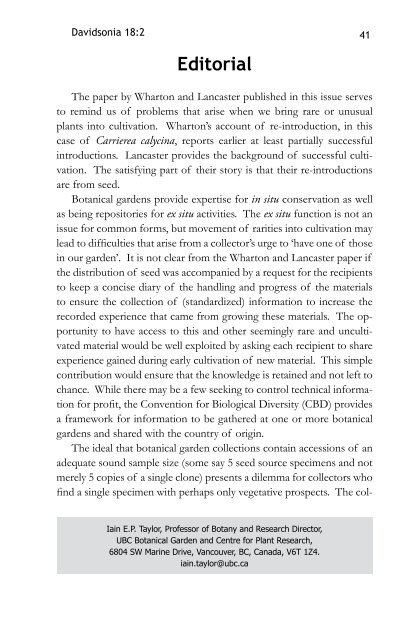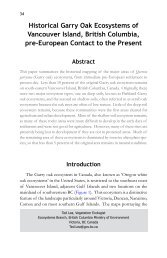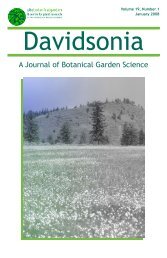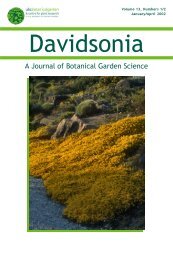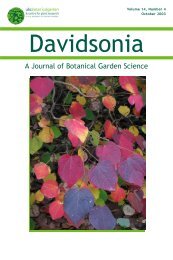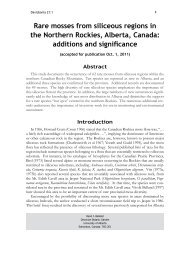in Vancouver, British Columbia, Canada - Davidsonia
in Vancouver, British Columbia, Canada - Davidsonia
in Vancouver, British Columbia, Canada - Davidsonia
You also want an ePaper? Increase the reach of your titles
YUMPU automatically turns print PDFs into web optimized ePapers that Google loves.
<strong>Davidsonia</strong> 18:2 41EditorialThe paper by Wharton and Lancaster published <strong>in</strong> this issue servesto rem<strong>in</strong>d us of problems that arise when we br<strong>in</strong>g rare or unusualplants <strong>in</strong>to cultivation. Wharton’s account of re-<strong>in</strong>troduction, <strong>in</strong> thiscase of Carrierea calyc<strong>in</strong>a, reports earlier at least partially successful<strong>in</strong>troductions. Lancaster provides the background of successful cultivation.The satisfy<strong>in</strong>g part of their story is that their re-<strong>in</strong>troductionsare from seed.Botanical gardens provide expertise for <strong>in</strong> situ conservation as wellas be<strong>in</strong>g repositories for ex situ activities. The ex situ function is not anissue for common forms, but movement of rarities <strong>in</strong>to cultivation maylead to difficulties that arise from a collector’s urge to ‘have one of those<strong>in</strong> our garden’. It is not clear from the Wharton and Lancaster paper ifthe distribution of seed was accompanied by a request for the recipientsto keep a concise diary of the handl<strong>in</strong>g and progress of the materialsto ensure the collection of (standardized) <strong>in</strong>formation to <strong>in</strong>crease therecorded experience that came from grow<strong>in</strong>g these materials. The opportunityto have access to this and other seem<strong>in</strong>gly rare and uncultivatedmaterial would be well exploited by ask<strong>in</strong>g each recipient to shareexperience ga<strong>in</strong>ed dur<strong>in</strong>g early cultivation of new material. This simplecontribution would ensure that the knowledge is reta<strong>in</strong>ed and not left tochance. While there may be a few seek<strong>in</strong>g to control technical <strong>in</strong>formationfor profit, the Convention for Biological Diversity (CBD) providesa framework for <strong>in</strong>formation to be gathered at one or more botanicalgardens and shared with the country of orig<strong>in</strong>.The ideal that botanical garden collections conta<strong>in</strong> accessions of anadequate sound sample size (some say 5 seed source specimens and notmerely 5 copies of a s<strong>in</strong>gle clone) presents a dilemma for collectors whof<strong>in</strong>d a s<strong>in</strong>gle specimen with perhaps only vegetative prospects. The col-Ia<strong>in</strong> E.P. Taylor, Professor of Botany and Research Director,UBC Botanical Garden and Centre for Plant Research,6804 SW Mar<strong>in</strong>e Drive, <strong>Vancouver</strong>, BC, <strong>Canada</strong>, V6T 1Z4.ia<strong>in</strong>.taylor@ubc.ca


